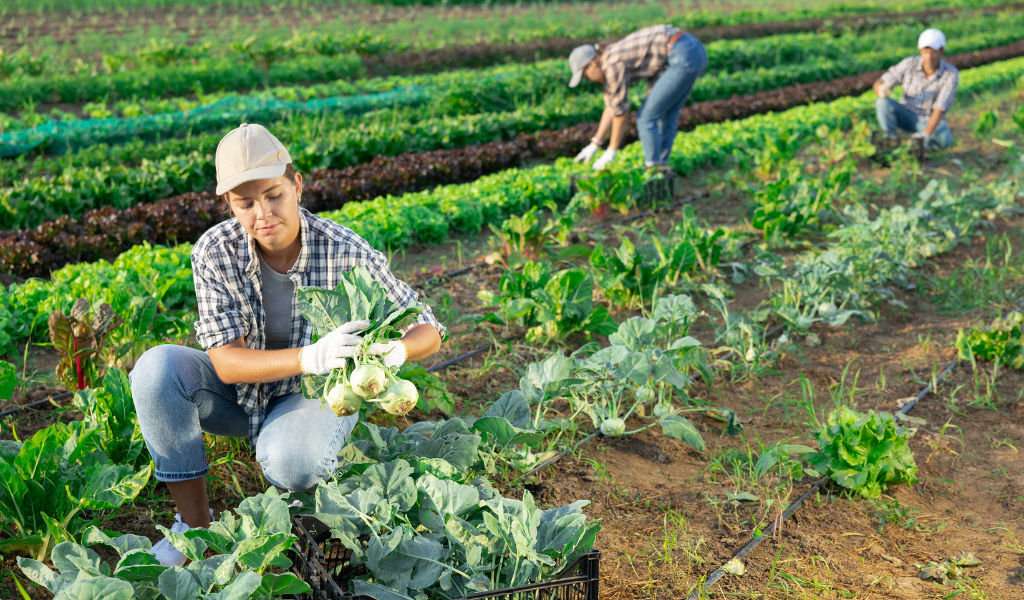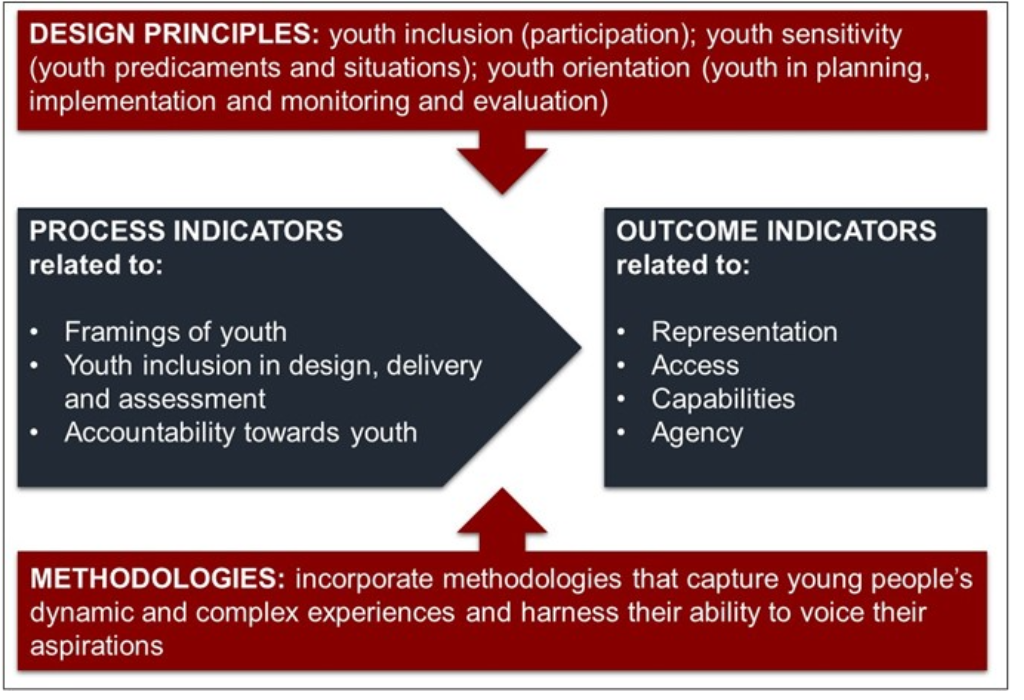Today’s youth generation holds a large stake in the future of sustainable agrifood systems worldwide. Youth are recognised as a key demographic in agricultural and rural development. But how should international agricultural research systems and organisations orient themselves towards youth? In a recent paper commissioned by the CGIAR Gender Impact Platform, we propose a framework of principles and practices to answer this and to guide agricultural research for development (AR4D) organisations.

Depictions of youth
Youth are often portrayed in paradoxical opposites. On one hand, youth are commonly framed as entrepreneurial innovators and creators of the future. On the other hand, they are sometimes portrayed as vulnerable to misdirection, engaging in risky behaviour, challenging the social order, and participating in rebellion, criminality, violence, or exodus.
These depictions are gendered, with both images more frequently applied to young men than young women. Female youth are more likely to be seen as vulnerable to violence and sexual exploitation, and fit for caring roles rather than entrepreneurial, technical or professional work.
Overall, youth are often represented as a simple and uniform demographic category, defined chiefly by age. These are formulaic and stereotyped representations that ignore or flatten the diversity and complexity of youth’s identities. They ignore the difference that intersections with gender, ethnicity, race, caste, class, religion and other factors can make as shapers of young people’s opportunities and experiences.
Alternative perspectives for more diverse youth framings
How can diversity and heterogeneity be incorporated in youth-oriented development projects? How can research, innovation and interventions in agrifood systems be sensitised to young people’s needs and priorities?
To answer those questions, we looked to the literature. Scholarly studies often view youth through the agency of young people as they attempt to navigate pathways through a landscape of opportunities that they find in the places and social structures where they live.
We found three alternative frames: youth as a transitional phase of life; youth in a generational perspective; and youth as an identity and cultural resource for action.
Youth and transition
At one time, youth was seen as a standard and universal experience that involved a common, linear transition from childhood into adulthood. Today, it is widely recognised that experiences of youth and transitions are embedded in social relations and cultural norms. Multiple pathways can unfold for youth in different contexts and situations, leading toward diverse and indeterminate individual and collective futures.
Being sensitive to these culturally and socially specific stories begs questions about how the institutional fabric around young people’s pathways shape their life course transitions? How pathways in different realms of life are interrelated and produce different outcomes for youth?
‘Generationing’ youth
A generational perspective highlights the social and structural framing of youth. On one hand, youth is a social construct that locates a generation of people within a sociohistorical context. Through processes of ‘generationing,’ youth acquire a collective and culturally situated sense of identity and a location in the social structure that can be performed by young people or imposed on them. On the other hand, each youth generation is enmeshed in relationships of family, kinship and community with older and younger generations. These relationships are sometimes interpreted as implicit intergenerational contracts.
By treating generation on a par with other structures that produce social categories and hierarchies, such as gender, class and race, we can ask how ‘generationing’ configures inequalities in power relations, asset regimes and political statuses? We can ask, how are different kinds of youth marginalised?
Youth as a sociocultural identity
The concept of social navigation is widely used to illustrate how young people can adopt and perform various identities to plot a course through a landscape of challenges and opportunities, shaped by their own aspirations and others’ expectations. Young people may combine multiple, distinct and overlapping statuses, and transitions between statuses can be contingent, contextual, and reversible.
The idea of social navigation defeats any remaining sense that there are uniform transitions for all youth, and prompts questions such as: What identities do youth accentuate in critical moments of change and moments of uncertainty? Who can do so, and in what situations and contexts?
Implications for AR4D
How can AR4D organisations orient themselves towards youth, be sensitive to the needs, concerns and predicaments of youth, and facilitate youth inclusion, voice, and participation?
First, they should use participatory and pedagogical approaches and methodologies that empower youth to find their own voice and articulate their own position. By listening to a range of youth, organisations can avoid subjecting them to assumptions about their needs, aspirations, and priorities.
Second, they should use the above approaches and methodologies to identify, investigate, analyse and understand specific situations and problems that particular youth may face. Youth-oriented research will generate detailed insights to develop new technologies that are relevant and accessible to youth, and be sensitive to diverse youth needs, priorities, and circumstances.
We propose overarching design principles and guidelines to generate suitable indicators to monitor progress towards better informed youth programming.
Principles for engaging with youth
We derived three overarching design principles that should guide agricultural research and programming for development (Fig. 1).
- Youth inclusion means enabling voice and facilitating participation by young people as key stakeholders.
- Sensitivity to youth implies recognizing that youth are heterogeneous and that their needs are diverse and context-specific in time, space and institutional setting.
- Youth orientation entails being accountable to youth, by ensuring that impacts on and for young people are monitored and evaluated, and that AR4D organizations hold themselves responsible and answerable to youth during the planning, implementation and delivery of projects and programs.

Principles for indicators to monitor progress
It would be misplaced to define universal indicators of youth orientation. Instead, we propose principles for developing suitable outcome and process indicators, which can be adapted to diverse settings.
Outcome indicators should be designed to detect changes in:
- Youth opportunity landscapes, such as improvements in access to productive resources, or enlargements in rights, entitlements and opportunities—while being sensitive to context and heterogeneity.
- Youth’s capabilities to improve their social and economic position, being mindful of class, gender, ethnic, and other differentiators that could justify a targeted approach to more marginalised youth subgroups.
- Youth’s agency to negotiate their positions within networks and structures of society and economy, including navigating gender and other cultural and social norms.
Process indicators should generate evidence that AR4D organisations and programmes:
- Promote the inclusion and participation of youth in programme design, delivery and impact evaluation.
- Invoke youth as a heterogenous group in programming and communications, in ways that recognise young people as stakeholders in AR4D and the future of agrifood systems, and as agents to be empowered and enabled to exercise choices in pursuit of their objectives.
- Hold themselves responsible and accountable toward youth.
More diverse and situated framings on youth are urgently needed. These design principles for engaging with youth and devising suitable outcome and process indicators are aligned with a more plural conceptualisation. Although our recommendations are specifically directed towards AR4D organisations, they are equally applicable to agrifood system research and practice more broadly.
